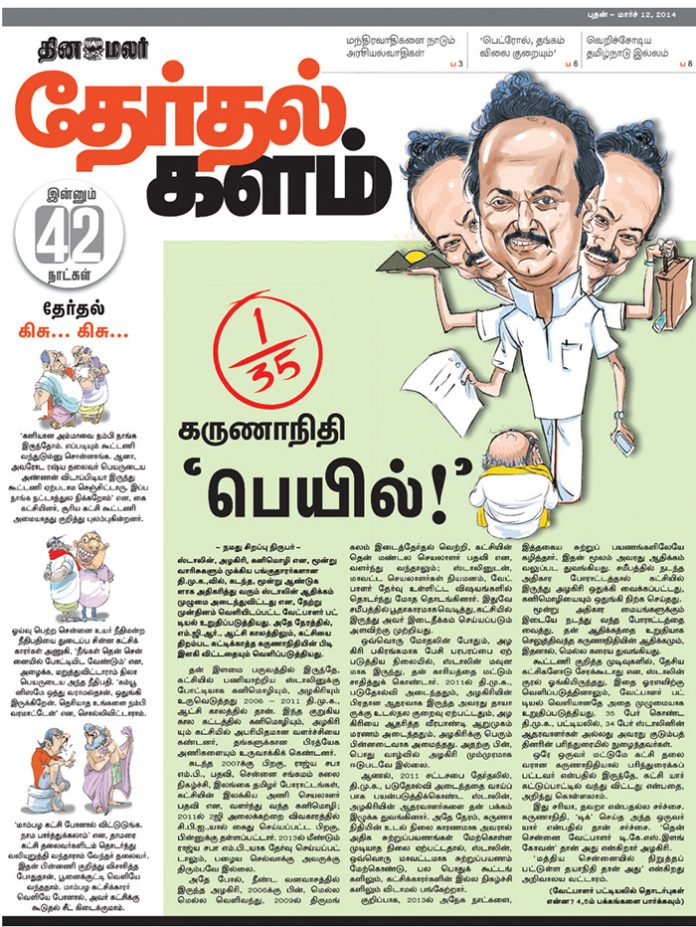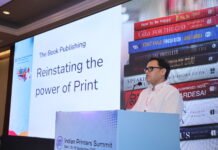
Dinamalar’s coverage of the 2014 Lok Sabha elections started on 30 December 2013 and ended on 25 April 2014, a day after polling ended in Tamil Nadu. The coverage started by allocating a special page for election news named Therthal Kalam which means Election Field. A week after starting, it was expanded to two pages daily. The two pages contained several sections such as a debate section where relevant issues of the day were debated by representatives from major political parties or by well known personages; and gossip and mini interview sections where people involved in major political developments spoke up alongside union and welfare association leaders using the opportunity to state their problems.
From 7 March onwards, Dinamalar turned Therthal Kalam into an 8-page daily tabloid supplement. The supplement was in addition to the two- page coverage in the main broadsheet section.
Before the start of its election coverage, Dinamalar identified core political and other issues that could turn into electoral issues for its readers including electricity and water scarcity, and challenges posed by industrial development. The election pages and supplements provided a 360 degree coverage to these issues by involving the ruling party, opposition parties, government officers, industry representatives and people. If it took up the electricity problem, apart from reporting protests against power cuts, it would also have the analysis, followed by industry leaders writing about how businesses were being affected.
Common people were also interviewed to take note of hindrances faced by them; as well as small traders to highlight the impact of power cuts on their trade and so on. It was an inclusive effort to make sure that most sections of the society had their say in the major issues faced by the state. This helped in developing, more or less, a uniform and thorough process about these issues.
Feedback mechanism
Dinamalar also set up a feedback mechanism to constantly monitor how its coverage of core issues was being perceived and how the understanding of certain issues changed with increased coverage. By doing this, it was able to fine-tune its coverage to enable a deeper understanding of issues among voters. Dinamalar also carried out daily short, snippet type interviews with first-time voters.
Nevertheless, even though this was a national election, as always, the actual voting was based on local and state-level issues. In addition, since Modi was being projected by the BJP, there was a good amount of personality politics involved, which is generally welcomed by voters in Tamil Nadu. In a sense, this election was similar to when Rajiv Gandhi and Atal BihariVajpayee were re-elected.
Hence, the coverage ratio was fixed at 70 (local/state issues): 20 (personality politics): 10 (national politics). At times, a few readers did ask for more national political coverage, but this ratio worked well for the majority of Dinamalar’s readers.
As far as competition is concerned, newspapers enjoy a unique advantage over TV when it comes to electoral coverage. This is because a majority of political developments happen behind the screens and as such, most information can only be obtained off the record, especially in Tamil Nadu, where there is a culture of secrecy.
Therefore, most of the exclusives and breaking stories were by newspapers, as usual. TV has the advantage of relaying live election campaign speeches but more than listening to speeches that are an hour or two-hours long, news consumers prefer to read the main points made in the speeches with an analysis which newspapers are able to deliver the very next morning. TV
channels also came up with some innovative coverage approaches, but in most cases, newspapers had the lead in reporting election news and delivering analysis. A micro-site was also set up within www.dinamalar.com for election news. This site opened before the main site and drew a number of regular online readers into the election news coverage.














